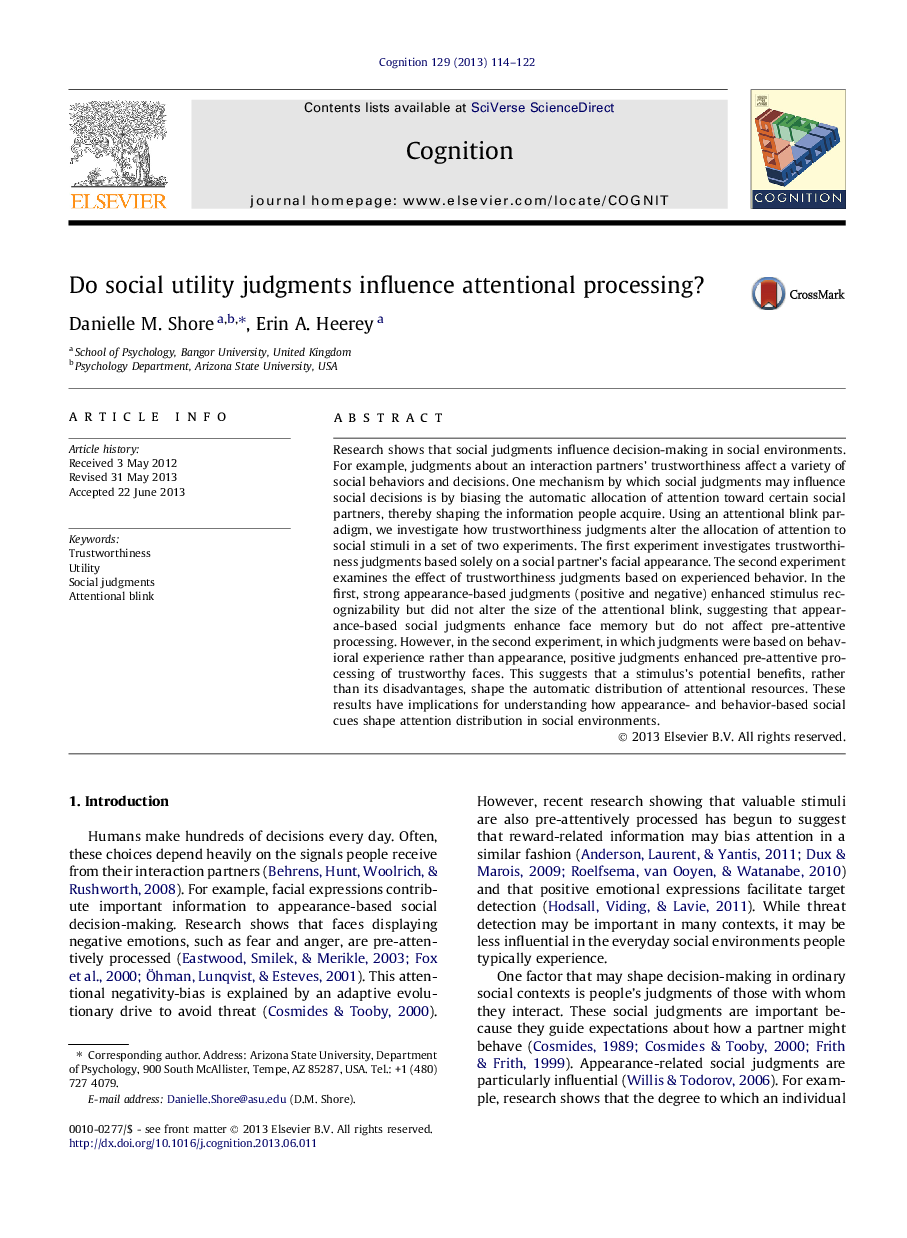| کد مقاله | کد نشریه | سال انتشار | مقاله انگلیسی | نسخه تمام متن |
|---|---|---|---|---|
| 10457694 | 921863 | 2013 | 9 صفحه PDF | دانلود رایگان |
عنوان انگلیسی مقاله ISI
Do social utility judgments influence attentional processing?
ترجمه فارسی عنوان
آیا قضاوت های اجتماعی سود بر پردازش توجه دارند؟
دانلود مقاله + سفارش ترجمه
دانلود مقاله ISI انگلیسی
رایگان برای ایرانیان
کلمات کلیدی
امانت، سودمند قضاوت های اجتماعی، چشمک زدن،
ترجمه چکیده
تحقیقات نشان می دهد که قضاوت های اجتماعی بر تصمیم گیری در محیط های اجتماعی تاثیر می گذارد. به عنوان مثال، قضاوت در مورد اعتماد به نفس شرکای تعامل، بر انواع رفتار و تصمیمات اجتماعی تاثیر می گذارد. یکی از مکانیسم هایی که قضاوت های اجتماعی ممکن است بر تصمیمات اجتماعی تاثیر بگذارد، این است که با توجه به تخصیص خودکار توجه به برخی از شرکای اجتماعی، به این ترتیب اطلاعات افراد را به دست آورد. با استفاده از پارادایم بلینک توجه، ما بررسی می کنیم که چگونه قضاوت های اطمینان، تخصیص توجه به محرک های اجتماعی در مجموعه ای از دو آزمایش را تغییر می دهند. اولین آزمایش، قضاوت های قابل اعتماد را براساس ظاهر چهره شریک اجتماعی انجام می دهد. آزمایش دوم، بررسی تأثیر قضاوت های قابل اطمینان بر اساس رفتار تجربه شده است. در ابتدا، قضاوت های مبتنی بر ظاهر قوی (مثبت و منفی) باعث تشخیص انگیزه افزایش یافته اما اندازه چشمک زدن توجهی را تغییر نمی دهند، که بیان می کند که قضاوت های اجتماعی مبتنی بر ظاهر باعث افزایش حافظه موقت می شود، اما بر پردازش دقت توجه نمی کند. با این حال، در آزمایش دوم، که در آن قضاوت بر اساس تجربه رفتاری، نه به ظاهر، قضاوت های مثبت، پردازش های پیش دقت از چهره های قابل اعتماد را افزایش داد. این نشان می دهد که مزایای بالقوه محرک، به جای معایب آن، توزیع خودکار منابع توجه را شکل می دهد. این نتایج دلالت بر فهمیدن اینکه نشانه های اجتماع مبتنی بر رفتار ظاهری و رفتاری باعث ایجاد توزیع توجه در محیط های اجتماعی می شود.
موضوعات مرتبط
علوم زیستی و بیوفناوری
علم عصب شناسی
علوم اعصاب شناختی
چکیده انگلیسی
Research shows that social judgments influence decision-making in social environments. For example, judgments about an interaction partners' trustworthiness affect a variety of social behaviors and decisions. One mechanism by which social judgments may influence social decisions is by biasing the automatic allocation of attention toward certain social partners, thereby shaping the information people acquire. Using an attentional blink paradigm, we investigate how trustworthiness judgments alter the allocation of attention to social stimuli in a set of two experiments. The first experiment investigates trustworthiness judgments based solely on a social partner's facial appearance. The second experiment examines the effect of trustworthiness judgments based on experienced behavior. In the first, strong appearance-based judgments (positive and negative) enhanced stimulus recognizability but did not alter the size of the attentional blink, suggesting that appearance-based social judgments enhance face memory but do not affect pre-attentive processing. However, in the second experiment, in which judgments were based on behavioral experience rather than appearance, positive judgments enhanced pre-attentive processing of trustworthy faces. This suggests that a stimulus's potential benefits, rather than its disadvantages, shape the automatic distribution of attentional resources. These results have implications for understanding how appearance- and behavior-based social cues shape attention distribution in social environments.
ناشر
Database: Elsevier - ScienceDirect (ساینس دایرکت)
Journal: Cognition - Volume 129, Issue 1, October 2013, Pages 114-122
Journal: Cognition - Volume 129, Issue 1, October 2013, Pages 114-122
نویسندگان
Danielle M. Shore, Erin A. Heerey,
